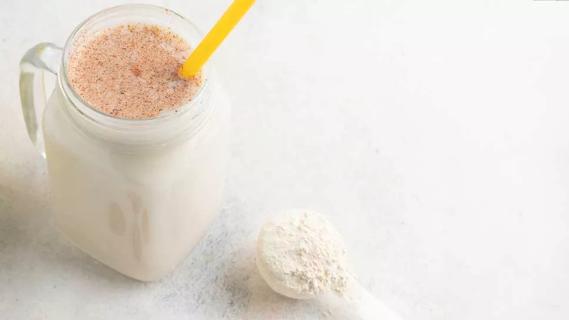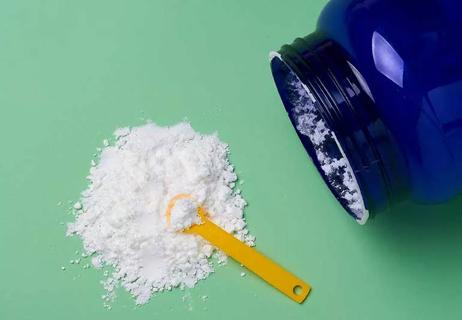Skip the shakes and powders and choose these whole foods instead

Let’s talk protein. You need it, says registered dietitian Anna Taylor, MS, RD, LD, CDE: “Healthy sources of protein might even decrease your risk for heart disease and stroke.”
Advertisement
Cleveland Clinic is a non-profit academic medical center. Advertising on our site helps support our mission. We do not endorse non-Cleveland Clinic products or services. Policy
But how much do you need? And what are the best sources of it? (Spoiler alert: Not as much as you may think. And they’re in whole foods you probably have in your house right now.)
So if you’re looking to add a little extra protein power (not powder) to your day, Taylor offers her top suggestions of where to find it.
“If you’re a healthy adult, with a typical digestive tract, the likelihood of having a protein deficiency is small,” says Taylor. “On the flip side, you can definitely overdose on protein, which could put your kidneys at risk and cause other unwanted side effects. Don’t go overboard with protein.”
The recommended dietary allowance (RDA) for protein is a little over 7 grams per 20 pounds of body weight. Using this guideline, a 140-pound person would need at least 50 grams of protein each day.
Taylor suggests finding high-quality protein sources that don’t come with the extras that could negatively affect your health: salt, sugar and saturated fat. So what are her low-fat, go-to veggie and animal protein sources?
“People often overlook vegetarian sources of protein, even though many are protein powerhouses,” says Taylor. “Veggie sources of protein come with fiber, which you won’t find in animal sources.”
Advertisement
Edamame (soybeans) is one of Taylor’s favorites: “Edamame’s a fantastic source of protein. In the plant world, there are very few sources of protein that have all of the necessary essential amino acids. Soy is one of those rare plant sources of complete protein.”
The skinny on one-half cup of fresh edamame:
How to use them: “Buy them frozen and shelled, so you don’t have to do any work,” says Taylor. “Just throw into stir-fries. Or eat them plain. My toddler loves edamame as finger food.”
Lentils are another legume powerhouse. “I love lentils. They’re really economical when you buy them dried,” says Taylor. “While there are different types of lentils, they are all similar in terms of their nutritional value.”
The skinny on one-half cup of cooked lentils:
How to use them: Lentils cook fast — in 20 to 30 minutes — so they’re easy to incorporate into soups. “I also throw them into other dishes, like if I’m making brown rice, which by itself is very … lackluster. By adding lentils, you’re suddenly at a higher protein count for the dish.”
“People expect me to list quinoa in my list of faves, and it’s great, but you have to eat a whole cup of it to get the protein power you get with legumes. Split peas are a legume that packs a punch,” says Taylor.
The skinny on one-half cup of cooked split peas:
How to use them: “You can buy them dried and simmer for 1 to 2 hours,” says Taylor. “Split peas work really well in soups because they absorb the liquid.”
Animal protein sources provide all the amino acids your body needs to operate at peak performance. If you choose wisely, you can take advantage of these high-quality protein sources and skimp on the saturated fat.
“Ounce-for-ounce, boneless, skinless chicken breast is higher in protein than your normal cuts of beef,” says Taylor. “Plus, chicken doesn’t come with extra saturated fat and, cost-wise, it’s accessible to the average person.”
The skinny on 3 ounces of chicken breast:
How to use it: There are countless ways to use chicken breast. Substitute it for beef or pork in recipes or cook it and add it to a salad or sandwich.
“I’m a big fan of plain, fat-free Greek yogurt — it’s amazing for you. It has live and active cultures, which are probiotics that help support a healthy gut,” says Taylor.
The skinny on one-half cup of plain, fat-free Greek yogurt:
Advertisement
How to use it: “The first time you taste it, you might say, ‘I don’t love it,’” says Taylor. “I get it. But you don’t have to eat it plain. Try it as a substitute for sour cream. Or add some frozen fruit at the beginning of the day. By lunch, the fruit will melt and add juice and flavor to the yogurt.”
Cottage cheese works well for people who don’t have a lot of food prep time. Taylor recommends buying a no-salt added version when you can find it.
The skinny on one-half cup of 1% cottage cheese:
“Canned tuna is a convenient, healthy food that doesn’t have the saturated fats that clog arteries,” says Taylor. “It’s economical and won’t go bad, so it’s there when you need it.”
The skinny on 3 ounces of canned tuna:
How to use it: “Add a tiny bit of mayo and use it on a sandwich or crackers. Eat it plain. Or use it in pasta salads. There are lots of ways you can use tuna.”
“People often think the yolk is where all the nutrients are, but that’s not true,” says Taylor. “Egg whites are almost pure protein and don’t contain any saturated fat.”
The skinny on four egg whites (or one-half cup of egg whites from a carton):
Advertisement
How to use it: Hard-boiled, scrambled or as a substitute in recipes — egg whites can be used in a variety of ways.
Advertisement
Learn more about our editorial process.
Advertisement

Leucine is an amino acid that helps you build muscle — it’s found in both plant and animal protein

Adding protein powder to coffee can provide benefits, but ‘proffee’ is no substitute for nutritious food

While rare in the U.S., signs that you’re not getting enough of this essential macronutrient include muscle loss, skin changes and a weak immune system

The concept of morning protein and exercise isn’t backed by research but may have some potential benefits

Bone broth may help maintain strong bones, improve gut health and even lessen joint pain

The general rule is 0.8 to 1 gram of protein per kilogram of body weight — but that may not be right for you

This edible insect powder can be a good source of protein, fiber and other nutrients

This amino acid is in lots of energy drinks, but our bodies already make all we need

If you’re feeling short of breath, sleep can be tough — propping yourself up or sleeping on your side may help

If you fear the unknown or find yourself needing reassurance often, you may identify with this attachment style

If you’re looking to boost your gut health, it’s better to get fiber from whole foods